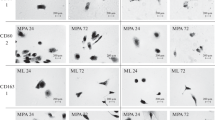Summary
The purpose of this investigation was to analyse the macrophage subpopulations involved in the uptake of endotoxin in the liver.
The results show that in normal B10.D2 mice the liver macrophages constitute a heterogeneous population of cells which, depending on their state of differentiation, are distinguished by their differential distribution in the liver acinus and by their ability to phagocytose latex.
Following the intravenous administration of endotoxin (lipopolysaccharide=LPS) from Salmonella abortus equi, endotoxin-carrying non-parenchymal cells of the liver (NPLC) were investigated immunohistochemically (in situ) and immunocytochemically (after isolation) between 1 h and 14 days after the injection. The endotoxin content of the blood and of isolated NPLC was also determined, using radioactively labeled LPS.
Following LPS injection, the total number of macrophages in the liver increased, reaching a maximum after 3 days. There was a striking increase in the ratio of mature to immature macrophages. After day 3, the number of macrophages decreased again, returning to the pre-injection values by day 14.
1 h after the administration of LPS, 41% of the isolated NPLC were already endotoxin-positive, a percentage which remained constant until the 3rd day. Thereafter, the number of LPS-bearing cells increased to a maximum of about 52% on the 5th day. This increase mostly involved macrophages which had taken up endotoxin. Concurrent with these changes there was a threefold increase in radioactively-labeled LPS from the 7th h to the 5th day after injection. Since the increase in the number of endotoxin-carrying macrophages in the liver occurred after endotoxin had been eliminated from the circulation, the increase must have resulted from endotoxin-carrying cells migrating into the liver from other organs.
Similar content being viewed by others
References
Braude AI (1964) Absorpiton distribution and elimination of endotoxin and their derivates. In: Landy M, Braun W (eds) Bacterial endotoxins. Rudgers University Press, New Brunswick NY, pp 98–109
Bross KJ, Pangalis GA, Staatz CG, Blume KG (1978) Demonstration of cell surface antigens and their antibodies by the peroxidase-antiperoxidase method. Transplantation 25: 331–334
Freudenberg MA and Galanos C (1985) Alterations in rats in vivo of the chemical structure of lipopolysaccharide from Salmonella abortus equi. Eur J Biochem 152: 353–359
Freudenberg MA, Bøg-Hansen TC, Back U, Jerillo E, Galanos C (1980) Interaction of lipopolysaccharide with plasma high-density-lipoprotein in rats. Infec Immunol 28: 373–380
Freudenberg MA, Freudenberg N, Galanos C (1982) Time course of cellular distribution of endotoxin in liver, lungs and kidneys of rats. Br J Exp Pathol 63: 56–65
Freudenberg N, Freudenberg MA, Guzman J, Mittermayer CH, Bandara K, Galanos C (1984) Identification of endotoxin— positive cells in the rat lung during shock. Virchows Arch [A] 404: 197–211
Freudenberg N, Galanos C, Datz O, Hämmerling G, Katschinski T, Schalk J, Pein U, Stübig H, and Freudenberg MA (1989b) Mechanism of replacement of non-parenchymal liver cells (NPLC) In: Murine radiation chimeras. Virchows Arch [A] 415: 203–209
Freudenberg N, Schalk J, Galanos C, Katschinski T, Datz O, Pein U, and Freudenberg MA (1989a) Identification and percentage frequency of isolated non-parenchymal liver cells (NPLC) in the mouse. Virchows Arch [B] 57: 109–115
Galanos C, Freudenberg MA, Reutter W (1979a) Galactosamine-induced sensitisation to the lethal effects of endotoxin. Proc Nalt Acad USA 76: 5939–5943
Galanos C, Lüderitz O, Westphal O (1979b) Preparation and properties of a standardized lipopolysaccharide from Salmonella abortus equi (Novo-Pyrexal) Zbl Bakt Hyg I [Abt Orig A] 243: 226–244
Kleine B, Freudenberg MA, Galanos C (1985) Excretion of radioactivity in faeces and urine of rats injected with3H14C-lipopolysaccharide. Br J Exp Pathol 66: 303–308
Malorny U, Michels E, Sorg C (1986) A monoclonal antibody against an antigen present on mouse macrophages and absent from monocytes. Cell Tissue Res 243: 421–428
Mathison JC and Ulevitch RJ (1979) The clearence tissue distribution and cellular localization of intravenously injected lipopolysaccharide in rats. J Immunol 123: 2133–2143
McLean IW, Nakane PF (1974) Periodate-lysine-paraformaldehyde fixative; a new fixative for immunoelectron microscopy. J Histochem Cytochem 22: 1077–1083
Sleyster EC, Knook DL (1982) Relation between localization and function of rat liver Kupffer cells. Lab Invest 47: 484–490
Author information
Authors and Affiliations
Rights and permissions
About this article
Cite this article
Freudenberg, N., Piotraschke, J., Galanos, C. et al. The role of macrophages in the uptake of endotoxin by the mouse liver. Virchows Archiv B Cell Pathol 61, 343–349 (1992). https://doi.org/10.1007/BF02890437
Received:
Accepted:
Issue Date:
DOI: https://doi.org/10.1007/BF02890437




